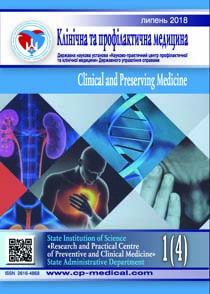Abstract
In Ukraine cerebrovascular pathology accounts for 20-40 % of all brain diseases, and among patients 20-30 % of the working age population. The increase in the number of central nervous system diseases in our country is mainly due to chronic, slowly progressive forms - dyscirculatory encephalopathies. The purpose of this research is to study the clinical, neurological and neuropsychological features of cerebrovascular disorders in persons of the working age.
Materials and methods of the study: 90 patients aged 40 to 68 were examined, 90 of them had dyscirculatory encephalopathy (DE). Patients with dyscirculatory encephalopathy were divided into two groups: the first group of patients with DE and arterial hypertension (AG) - 60, the second with DE without AG - 30. All patients underwent clinical and neurological and clinical and instrumental examination.
Research results. According to the results of the assessment of subjective and objective neurological symptoms among the patients in the first group 61.7% of them had cephalic, 55 % vestibular, 31.7 % cerebrospinal, 28.3 % mnemonic syndromes and in 23.3 % were observed anxiety- depressive disorders. Among the patients in the second group, 66.6 % had cephalic, 43.3 % vestibular, 46.6 % cerebrospinal, 23.3 % mnemonic syndromes, 20 % had anxiety-depressive disorders and 20 % pyramidal insufficiency. In patients with hypertonic dyscirculatory encephalopathy, with an increase in the rate of depression and anxiety, the average of the memory indicator decreases. According to the results of the study, it has been proved that there is a significant increase in the elasticity of the vessel wall in patients with DE and AG. Conclusions. A significant deterioration of memory, MMSE scale, (p <0.003) in patients with dyscirculatory encephalopathy without arterial hypertension was detected. In the study of emotional-volitional disorders in people of the working age, it has been proved that in a patient with dyscirculatory encephalopathy, in the case of arterial hypertension, there was a significant prevalence of anxiety (p <0.001) and depression (p = 0.033). It has been shown that the increase in the rate of depression and anxiety in patients with dyscirculatory encephalopathy with the arterial hypertension at the background decreases the rate of overall cognitive productivity, orientation and memory.
References
2. Dadasheva, M., Podrezova, L., Shuchalin, O. (2011). Algoritm terapii discirculatornoy entsefalopatii u bolnih s arterialnoy hipertensiey v obchevrachebnoy practike. [Algorithm of therapy of discirculatory encephalopathy in patients with arterial hypertension in general medical practice]. Breast cancer, 17 (20), 1320-1324.
3. Mishchenko, T., Dmitrieva, E., Mishchenko, V. (2015). Primenenie tanakana v terapii kognetivnih naruscheniy u postinsultnih bolnih [Application of tanakan in the therapy of cognitive disturbances in post-stroke patients]. Neiro News, № 7, 27-31.
4. Mischenko, T., Shestopalova, L., Kozhevnikova, V., Lapshin, I. (2011). Hipertensivnaya discirculatornaya ensefalopatiya i sosudistaya demensiya. [Hypertensive dyscirculatory encephalopathy and vascular dementia]. Liki Ukrainy, 5, 57-60.
5. Ostroumova, O. D. (2013). Arterialnaya hipertensiya i trevozhnye sostoyaniya. [Arterial hypertension and anxiety states]. Cardiology, 2, 95-99.
6. Polivoda, S., Shalmina, M., Solovyuk, A. (2012). Patogenetiheskiye mehanizmi rasvitiya hronicheskoy gipertensivnoy discirculatornoy encefalopatii u bolnih hipertonicheskoy bolezniu. [Pathogenetic mechanisms of development of chronic hypertensive discirculatory encephalopathy in patients with essential hypertension (review of the literature and the results of their own observations. Zaporozhye Medical Journal, 1 (34), 82¬86.
7. Treschinskaya, M. (2013). Arterialnaya hipertensiya i cerebrovascularnaya patologia. [Arterial hypertension and cerebrovascular pathology]. News of Medicine and Pharmacy, Special Issue, 30-35.
8. Khobzey, M., Mishchenko, Т., Zinchenko, O., Golubchikov, M. (2011). Stan nevrologichnoi slyzhbu y 2011 rozi. [State of the neurological service in Ukraine in 2011]. News of Medicine and Pharmacy, 339, 69-79.
9. Bech-Azeddine, R., Hogh, P., Juhler, M. Gjerris, F., Waldemar, G. (2011). Idiopathic normal-pressure hydrocephalus: clinical comorbidity correlated with cerebral biopsy findings and outcome of cerebrospinal fluid shunting J. Neurol. Neurosurg, Psychiatry, 78 (2), 157-161.
10. De Haan, E. H., Nys, G. M., V. Van Zandvoort, M. J. (2012). Cognitive function following stroke and vascular cognitive impairment. Curr. Opin. Neurol, 19, 559-564.
11. Rockwood, K., Moorhouse, P. K., Song, X. (2012). Disease progression in vascular cognitive impairment: cognitive, functional and behavioral outcomes in the Consortium to Investigate Vascular Impairment of Cognition (CIVIC) cohort study. J. Neurol. Sci., 252(2), 106-¬112.
12. Galluzi, S., Sheu, C.F., Zanetti, O., Frisoni, G. B. (2013). Distinctive clinical features of mild cognitive impairment with subcortical cerebrovascular disease.Dement. Geriatr. Cogn. Disord., 19, 196¬-203.
13. Folstein, M. F., Folstein, S. E., McHugh, P. R. (2012). A practical method for grading the cognitive state of patients for the clinician. J. Psychiatr. Res.,12(3), 189–198.
14. Serrano, S., Domingo, J., Rodríguez¬ Garcia, E. (2012). Frequency of cognitive impairment without dementia in patients with stroke: a two¬-year follow¬-up study. Stroke, 38(1), 105-¬110.
15. Reitz, C., Tang, M. X., Manly, J. (2012). Hypertension and the risk of mild cognitive impairment. Arch. Neurol, 64(12), 1734-¬1740.
16.de la Torre, J. C. (2012). Cerebral hemodynamics and vascular risk factors: setting the stage for Alzheimer’s disease. J. Alzheimers. Dis., 32(2), 553-567.
17. Hershey, L. A., Olszewski, W. A. Ischemic vascular dementia. New York, Marcel Dekker, 335–351.
18. Lovibond, P. F, Lovibond, S. H. (2013). The structure of negative emotional states: comparison of the Depression Anxiety Stress Scales (DASS) with the Beck depression and anxiety inventories. Behav. Res. Ther., 33, 335–342.
19. Pantoni, L., Garsia, J. (2012). Pathogenesis of leukoaraiosis. Stroke, 28, 652–659.
20. Debette, S., Bombois, S., Bruandet, A., Delbeuck, X. (2013). Subcortical hyperintensities are associated with cognitive decline in patients with mild cognitive impairment. Stroke, 38(11), 2924¬-2930.

This work is licensed under a Creative Commons Attribution-NonCommercial 4.0 International License.

